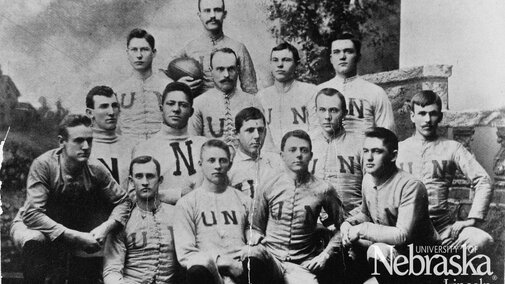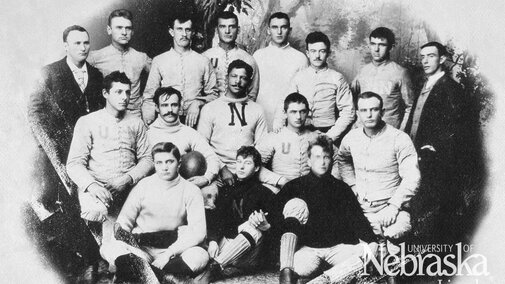
Dr. George A. Flippin
George Albert Flippin was born February 8, 1868 in Ohio to Charles and Mahala Flippin.
His father, Charles, was a freed slave who fought in the Civil War on behalf of the Union in the 14th US Colored Troops, Company A. After the death of Mahala in 1871, Charles and his two children moved to Marion County, Kansas. Charles attended the Bennett Eclectic Medical School in Chicago and became a doctor. In 1885 Charles married Mary Bell Reed, a white physician, who was also a graduate of the Bennett Eclectic Medical School. In 1888 the Flippin family moved to Henderson, Nebraska to set up a clinic and pharmacy.
George Flippin attended the University of Nebraska from 1891 to 1894. He was the first African-American football player for the university. Missouri refused to play a scheduled football game, forfeiting 1-0 because of Flippin’s presence on the team.
George married Georgia Smith in 1895. Georgia, from Des Moines, Iowa, was a piano student at the Nebraska Conservatory of Music in Lincoln prior to their marriage. They had two children, Dorothy May (Jeffers) and Robert Browning Flippin.
In 1907 George moved to Stromsburg, Nebraska where his father and step-mother had established a medical practice in 1900. He built the first hospital in Stromsburg which is now the local Bed and Breakfast. George was part of an early civil rights case in Nebraska when he was denied service at a York restaurant. Contrary to local legend, George did not own one of the first automobiles in Stromsburg. That notoriety belonged to his father, Charles. In 1910 George endured the scandal of a divorce and subsequent marriage to local Swede, Miss Mertina Larson.
George was a respected physician and surgeon known across the county and state for his willingness to make house calls regardless of the distance or the ability of the family to pay. George Flippin died May 15, 1929 and is the only African-American buried in the Stromsburg Cemetery.
He was inducted into the Nebraska Football Hall of Fame in 1974.
The Flippin Project
In September 2011, the University of Nebraska-Lincoln honored Dr. George A. Flippin's legacy with the unveiling of a new art project bearing his likeness at the Jackie Gaughan Multicultural Center.
The iconic, four-by-six-foot mural-style portrait of Flippin standing proudly in his Nebraska football uniform – a white sweater emblazoned with a red ‘N' – was the culmination of the work of a dozen student volunteers.
The creative process
The Flippin Project, as it became known, provided an opportunity to transcend cultural boundaries through art by enlisting the talents of the volunteers from Prof. Aaron Holz's advanced painting class in the Hixson-Lied College of Fine and Performing Arts. Holz and Jon Humiston, creative director at UNL's Office of University Communications, divided a black-and-white photo of Flippin into 24 equal-sized squares, then asked each student to paint two of them. No other creative instruction was given, so students could interpret and paint their slices of the overall portrait in whatever manner they chose.
The result is a fascinating patchwork of styles, colors, effects and interpretations that reflect the students' diversity while unifying to form the iconic image of the university's pioneering student-athlete.
Bringing history to life
Students worked independently, researching Flippin's life and his contributions to the university, before putting brushes to canvas.
"One of the most amazing things about George Flippin's story was that despite being the first free-born generation in his family, he was able to use his incredible talent to rise beyond the racial obstacles of the time," said Kyren Conley, a senior from Alliance who participated in the project. "I was also proud to learn that despite the times of widespread segregation and racism, his team supported and respected him."
Crystal Sanders, another of the student artists, graduated in August. She said she was pleased with how the mural came together and that like in football it required a team effort by the student artists. In the end, she said it will help to preserve Flippin's legacy at UNL. The mural will remain on permanent display at the Center.
"I am very proud to be a part of the history of the school I graduated from and I am proud of the school for acknowledging art as having importance," she said.
In addition to the mural's unveiling, several speakers during the event will discuss Flippin's life, his impact on the university and his contribution to the state.
- Steve Smith, University Communications
Dr. George A. Flippin

1891 Bugeaters football team.
George Flippin is in the 2nd row, 2nd from left
(with large N on his jersey).

1892 Bugeaters football team.
George Flippin is in the center
(with large N on his jersey).

1893 Bugeaters football team.
George Flippin is left of center in the image.

1894 Bugeaters football team.
George Flippin is in the middle row, 3rd from left
(in the dark-colored jersey).
